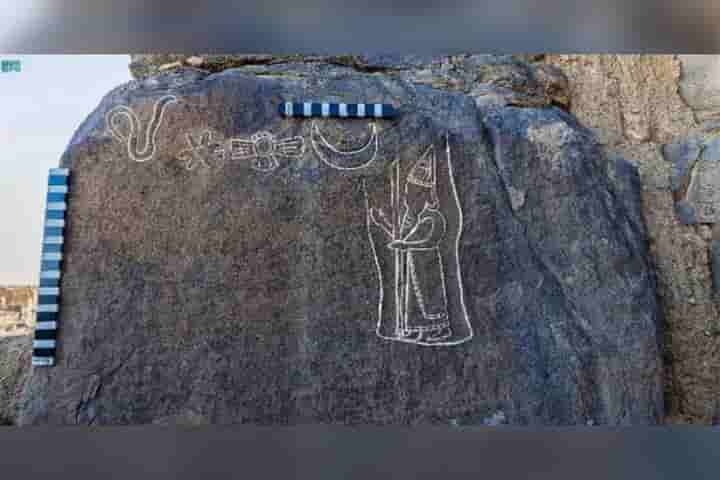By S.Ravi New Delhi, July 29: An important inscription has been recovered in Saudi Arabia recently which assumes historical significance as it could shed light on the ancient ties and historical bonds between the Arabian Peninsula and its ancient neighbours, namely Mesopotamia. According to a report published in smithsonianmag.com in Saudi Arabia researchers have discovered a sixth-century B.C.E. rock carving of the last Babylonian king, Nabonidus. The archaeologists from the Saudi Commission for Tourism and National Heritage, according to a report by Arab News, discovered this inscription. The 2,550-year-old inscription was found in the Al-Hadeed Governorate which lies in Saudi Arabia's northern Hail region, is engraved on a basalt stone. The official statement released by the authorities gives a fair description of the carvings. It states that the carving contains 26 lines of cuneiform writing. Thereby giving it the singular distinction of being the longest cuneiform inscription discovered in Saudi Arabia so far. The importance of the carving lies in the fact that it will help scholars and historians understand the ties that existed in the past between those living in the Peninsula and the neighbouring Mesopotamia. The inscription etched on the rock depicts the King of Babylon, standing and holding a sceptre in his hand. In front of the Emperor, four symbols hover around and these are that of a crescent moon, the sun, a snake and a flower. The experts and scholars feel that these images are of religious significance. They are still trying to determine what exactly these etchings mean and signify and for that they are comparing it to other ones of similar nature that have been discovered earlier. The History Blog, suggested that these markings may be possibly tied and connected with the deities in the Mesopotamian pantheon. Thus they stand for the star of Ishtar, the winged disc of the sun god Shamash and the crescent of the moon deity Sin. Owen Jarus in Live Science mentioned the importance of the location from where the inscription was found. It was discovered in the town of Al Hait, which in the past used to be known as Fadak. According to Jarus, Al Hait is home to the ruins of fortresses, rock art and water installations. According to the Saudi Commission for Tourism and National Heritage the site holds "great significance," as it boasts of an early history that is spread for a period beginning in the first millennium B.C.E. through the beginning of the Islamic era. Earlier too researchers have found in this region inscriptions and obelisks which mention Nabonidus, who was the ruler of Babylonia from 556 to 539 B.C.E., before his rule was finished when the kingdom fell to Cyrus of Persia, according to Arab News report. When the Babylonian Empire was its zenith, it was spread out from the Persian Gulf to the Mediterranean Sea. With Nabonidus assuming power of the kingdom, portions of what is presently in Saudi Arabia were also captured by him. After assuming power, four years later, Nabonidus announced his son Belshazzar as coregent. Thereafter, he went into exile in Tayma, a city which is located about 160 miles north of Al Hait. According to Live Science he stayed in Tayma until around 543 B.C.E. Experts and historians are not sure as to what made Nabonidus leave Babylon. On this aspect, Arkeonews stated that it was his "self-imposed exile from political and religious authority". This according to Arkeonews may have been the result of a coup. A reason for Nabonidus' departure could have been disputes between the clergy and Babylon's elite. History Blog suggests that by declaring the moon god to be superior to all other gods and deities, Nabonidus had attempted to alter the religious hierarchy of his people. This move on his part may have angered and irritated the nobility. There is not much known about Nabonidus, the last Babylonian king. This includes what happened to him after Babylon fell to Cyrus. According to Encyclopedia Britannica Nabonidus was captured by a general of Cyrus and exiled. (The content is being carried under an arrangement with indianarrative.com)
2,550-year-old inscription reveals Mesopotamia's ancient footprint on Arabian Peninsula
- by Rinku
- July 30, 2021 2 minutes

A 2,550-year-old inscription reveals Mesopotamia's ancient footprint on the Arabian Peninsula.(photo:IN)










